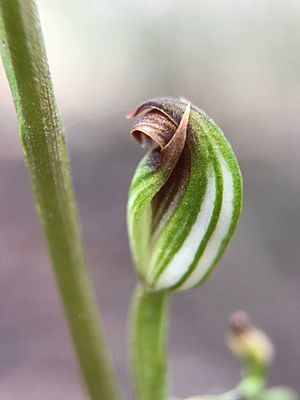Blushing tiny greenhood facts for kids
The blushing tiny greenhood (Pterostylis rubescens) is a special type of orchid that grows only in south-eastern Australia. It's called a "greenhood" because its flowers form a hood shape. Like many orchids, the plant looks different when it's flowering compared to when it's not. When it's not flowering, it has a group of leaves close to the ground. But when it's ready to bloom, it grows a tall stem with tiny green, white, and brownish flowers. These flowers can even turn a bit pink as they get older, which is why it's called "blushing"!
Quick facts for kids Blushing tiny greenhood |
|
|---|---|
 |
|
| Pterostylis rubescens growing near Canberra | |
| Scientific classification | |
| Genus: |
Pterostylis
|
| Species: |
rubescens
|
| Synonyms | |
|
Speculantha parviflora (R.Br.) D.L.Jones & M.A.Clem. |
|
Contents
What is a Blushing Tiny Greenhood?
The blushing tiny greenhood is a plant that grows from an underground tuber, which is like a small storage organ. It's a perennial plant, meaning it lives for more than two years. It's also deciduous, so some parts die back each year, usually in winter.
Leaves and Flowers
When the plant is not flowering, it has a group of five to fifteen leaves that lie flat on the ground. This group of leaves is called a rosette. Each leaf is shaped like an egg or a heart and is about 6 to 25 millimeters (0.2 to 1 inch) long. They are also about 3 to 18 millimeters (0.1 to 0.7 inches) wide.
When the plant flowers, it grows a thin, strong stem that can be 150 to 600 millimeters (6 to 24 inches) tall. This stem holds between three and eighteen small flowers. There are also three to six leaves wrapped around the flowering stem.
Flower Appearance
The flowers are almost round and have a mix of green and white colors near the bottom. They become brownish towards the tip. As the flowers get older, they often turn a pretty pink color.
The top part of the flower, called the "galea," looks like a hood. It's made from two parts: the dorsal sepal and the petals, which are joined together. This hood curves forward and has a slightly rough tip.
The side parts of the flower, called the lateral sepals, stand upright and stay close to the hood. They have narrow tips that are about 2 millimeters (0.08 inches) long. These tips do not stick out above the hood.
At the base of the lateral sepals, there's a small bulge with a tiny notch in the middle. This area is called the sinus. The labellum, which is a special lip-like petal, is about 4 millimeters (0.16 inches) long and 2 millimeters (0.08 inches) wide. You usually can't see it sticking out above the sinus.
This orchid usually blooms between January and May.
How it Got its Name
The blushing tiny greenhood was first officially described in 2008 by a botanist named David Jones. He first gave it the name Speculantha rubescens. His description was published in a magazine called The Orchadian.
Later, in 2010, another botanist named Gary Backhouse changed its name to Pterostylis rubescens.
Meaning of the Name
The second part of its scientific name, rubescens, comes from Latin words. The word ruber means "red" or "reddish." The ending -escens means "becoming." So, rubescens means "becoming reddish," which fits because the flowers can turn pinkish as they age.
Where it Lives
The blushing tiny greenhood grows on slopes and ridges. You can find it in open forests and woodlands. It is quite common in northern Victoria and in the central and southern tablelands of New South Wales.

